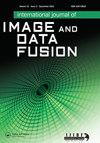Modified PLVP with Optimised Deep Learning for Morphological based Road Extraction
IF 1.8
Q3 REMOTE SENSING
International Journal of Image and Data Fusion
Pub Date : 2021-01-04
DOI:10.1080/19479832.2020.1864785
引用次数: 1
Abstract
ABSTRACT This paper introduces a new modified local pattern descriptor to extract road from rural areas’ aerial imagery. The introduced local pattern descriptor is actually the modification of the proposed local vector pattern (P-LVP), and it is named as Modified-PLVP (M-PLVP). In fact, M-PLVP extracts the texture features from both road and non-road pixels. The features are subjected to train the Deep belief Network (DBN); thereby the unknown aerial imagery is classified into road and non-road pixel. Further, to improve the classification rate of DBN, morphological operations and grey thresholding operations are performed and so that the road segmentation is performed. Apart from this improvement, this paper incorporates the optimisation concept in the DBN classifier, where the activation function and the count of hidden neurons are optimally selected by a new Trail-based WOA (T-WOA) algorithm, which is the improvement of the Whale Optimisation Algorithm (WOA). Finally, the performance of proposed M-PLVP is compared over other local pattern descriptors concerning measures like Accuracy, Sensitivity, Specificity, Precision, Negative Predictive Value (NPV), F1Score and Mathews correlation coefficient (MCC), False positive rate (FPR), False negative rate (FNR), and False Discovery Rate (FDR), and proves the betterments of M-PLVP over others.基于形态学道路提取的改进PLVP优化深度学习
提出了一种新的改进的局部模式描述符,用于从农村航拍图像中提取道路。引入的局部模式描述符实际上是对提出的局部向量模式(P-LVP)的修改,并将其命名为Modified-PLVP (M-PLVP)。实际上,M-PLVP同时提取道路和非道路像素的纹理特征。对特征进行深度信念网络(DBN)训练;从而将未知航拍图像分为道路像素和非道路像素。进一步,为了提高DBN的分类率,对DBN进行形态学运算和灰度阈值运算,从而进行道路分割。除了这种改进之外,本文还在DBN分类器中引入了优化概念,其中激活函数和隐藏神经元的数量通过一种新的基于trail的WOA (T-WOA)算法进行优化选择,该算法是对鲸鱼优化算法(WOA)的改进。最后,将所提出的M-PLVP与其他局部模式描述符在准确性、灵敏度、特异性、精密度、负预测值(NPV)、F1Score和Mathews相关系数(MCC)、假阳性率(FPR)、假阴性率(FNR)和假发现率(FDR)等方面的性能进行了比较,并证明了M-PLVP优于其他局部模式描述符。
本文章由计算机程序翻译,如有差异,请以英文原文为准。
求助全文
约1分钟内获得全文
求助全文
来源期刊

International Journal of Image and Data Fusion
REMOTE SENSING-
CiteScore
5.00
自引率
0.00%
发文量
10
期刊介绍:
International Journal of Image and Data Fusion provides a single source of information for all aspects of image and data fusion methodologies, developments, techniques and applications. Image and data fusion techniques are important for combining the many sources of satellite, airborne and ground based imaging systems, and integrating these with other related data sets for enhanced information extraction and decision making. Image and data fusion aims at the integration of multi-sensor, multi-temporal, multi-resolution and multi-platform image data, together with geospatial data, GIS, in-situ, and other statistical data sets for improved information extraction, as well as to increase the reliability of the information. This leads to more accurate information that provides for robust operational performance, i.e. increased confidence, reduced ambiguity and improved classification enabling evidence based management. The journal welcomes original research papers, review papers, shorter letters, technical articles, book reviews and conference reports in all areas of image and data fusion including, but not limited to, the following aspects and topics: • Automatic registration/geometric aspects of fusing images with different spatial, spectral, temporal resolutions; phase information; or acquired in different modes • Pixel, feature and decision level fusion algorithms and methodologies • Data Assimilation: fusing data with models • Multi-source classification and information extraction • Integration of satellite, airborne and terrestrial sensor systems • Fusing temporal data sets for change detection studies (e.g. for Land Cover/Land Use Change studies) • Image and data mining from multi-platform, multi-source, multi-scale, multi-temporal data sets (e.g. geometric information, topological information, statistical information, etc.).
 求助内容:
求助内容: 应助结果提醒方式:
应助结果提醒方式:


